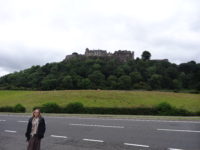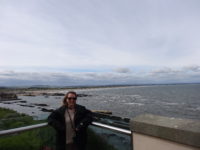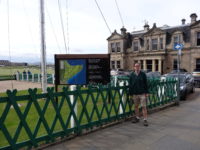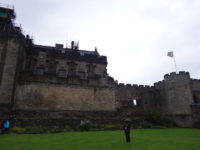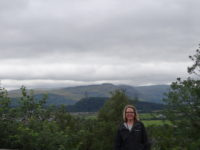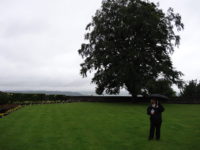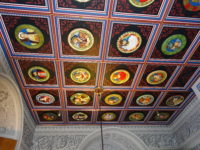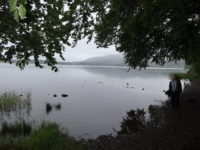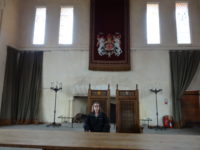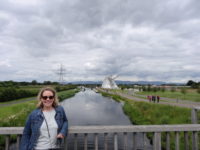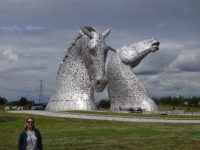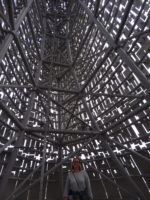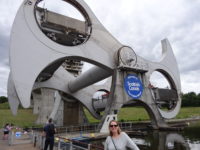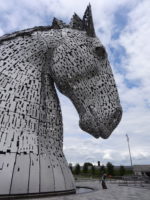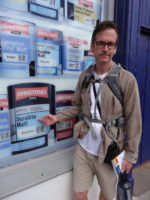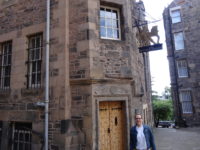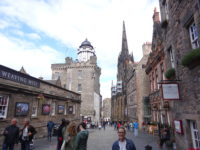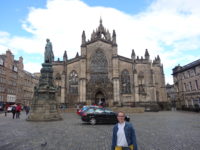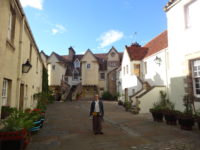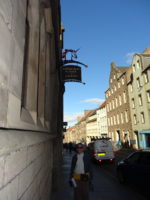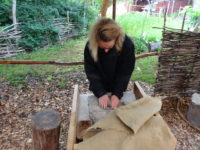 You know the weather is special when the Scots themselves complain about it. I can never remember shivering from cold before in late June, even when I was in the mountains in Austria and Italy. I shivered today – highs in the low fifties, strong and steady winds, and a steady, driving rain. It was cold. Welcome to June 29th!
You know the weather is special when the Scots themselves complain about it. I can never remember shivering from cold before in late June, even when I was in the mountains in Austria and Italy. I shivered today – highs in the low fifties, strong and steady winds, and a steady, driving rain. It was cold. Welcome to June 29th!
At breakfast, Meredith asked a cafeteria worker what the golfers at St. Andrews did on days like today. She was told they play – the golf only stops if conditions are life-threatening (like lightning). I can’t imagine paying over two hundred dollars to play eighteen holes of golf and then getting terrible weather, but they play on.
We got in the car and drove over an hour to Kenmore, to the Scottish Crannog Centre. A crannog is a hut built out in the water of a loch, either on logs driven into the bottom of the loch or on a pile of stones that have been built up from the bottom. There are the remains of dozens of crannogs in Scotland and Ireland, dating from as long as 2,500 years ago. No one is sure why the huts were built – it may have been for defense, it may have been a status symbol, or both. But, because the loch waters preserve the wood and other artifacts around the crannog site, they help archaeologists piece together a good picture of what life was like around the hut.
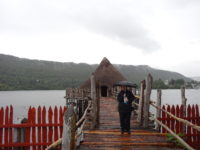 For starters, the Scottish Crannog Centre rebuilt a crannog using (mostly) traditional methods and materials; it took them three years, even with the aid of a not-so-Iron-Age chainsaw. So building these things was not easy, and once they were built, maintenance on them would have been ongoing.
For starters, the Scottish Crannog Centre rebuilt a crannog using (mostly) traditional methods and materials; it took them three years, even with the aid of a not-so-Iron-Age chainsaw. So building these things was not easy, and once they were built, maintenance on them would have been ongoing.
The scientists studying the crannog near the site of the reconstruction (on Loch Tay) found lots of artifacts – they found paddles from boats, one clay pot that may have been acquired through trade, some bronze and iron tools, a small piece of woven cloth which weavers were able to reproduce, stone weights and tools, wooden tools, seeds and bones and other food waste, and more. This led to a good picture of what life must have been like – hard, and short, with people not living past fifty, and many skeletons deformed from the physical labor the people had done.
The center was staffed with several helpful people who gave demonstrations of what crannog life may have involved, from drilling holes in stones to create weights for nets, to grinding grain for bread, to using a bow and stick to create fire (a labor-intensive task – much better not to let the fire go out). We got to go into the crannog itself, where twenty or more people would have slept, along with several of their animals. The crannog was surprisingly big, but still would have felt crowded to us; to the people of that time, it was free heat.
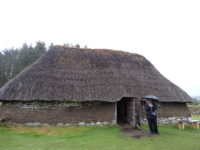 After lunch, we headed north to Newtonmore, which is in the Highlands, and is home to the Highland Folk Museum. It took longer than we thought to get there, so we only had about forty-five minutes to check it out. The museum has a four-building village to show what life was like in the 1700s in the area, and then several buildings from the early 1900s. We toured the 1700s buildings, which were made of wood, turf, thatch, and some stone. They were dark and smoky. The house would have held up to twenty people, with the adults sleeping up to five per bed. Meredith pointed out how little had changed in the two thousand years since the crannogs. Once again, I am glad I live with the comforts I live with.
After lunch, we headed north to Newtonmore, which is in the Highlands, and is home to the Highland Folk Museum. It took longer than we thought to get there, so we only had about forty-five minutes to check it out. The museum has a four-building village to show what life was like in the 1700s in the area, and then several buildings from the early 1900s. We toured the 1700s buildings, which were made of wood, turf, thatch, and some stone. They were dark and smoky. The house would have held up to twenty people, with the adults sleeping up to five per bed. Meredith pointed out how little had changed in the two thousand years since the crannogs. Once again, I am glad I live with the comforts I live with.
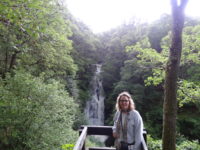 We left the Highlands and drove back south to Pitlochry, where our B and B is. Pitlochry is a very cute little town on the Tummel River. We checked in, and since the rain had finally stopped, we took a walk up into the woods to go see the Black Spout, a large waterfall nearby. It was a surreal hike – it was through woods covered in huge ferns, so it looked prehistoric. We were gone for over and hour and never saw another person. We almost gave up at one point, since we were not sure we were going to find the falls, but then we saw a small bridge, which then led us to a path that was marked with a signpost. So we found the Black Spout, which was worth the walk. The path there even has an impressive viewing platform so you can see the falls without any vegetation in the way.
We left the Highlands and drove back south to Pitlochry, where our B and B is. Pitlochry is a very cute little town on the Tummel River. We checked in, and since the rain had finally stopped, we took a walk up into the woods to go see the Black Spout, a large waterfall nearby. It was a surreal hike – it was through woods covered in huge ferns, so it looked prehistoric. We were gone for over and hour and never saw another person. We almost gave up at one point, since we were not sure we were going to find the falls, but then we saw a small bridge, which then led us to a path that was marked with a signpost. So we found the Black Spout, which was worth the walk. The path there even has an impressive viewing platform so you can see the falls without any vegetation in the way.
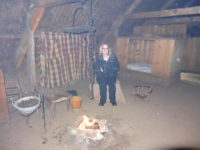 We walked back into town, where we had a very light supper (we have been eating a lot of late), and then back to the B and B. We persevered with Meredith’s touring plan despite the weather, and so it was a fine day in the end. In the warm and dry room.
We walked back into town, where we had a very light supper (we have been eating a lot of late), and then back to the B and B. We persevered with Meredith’s touring plan despite the weather, and so it was a fine day in the end. In the warm and dry room.

